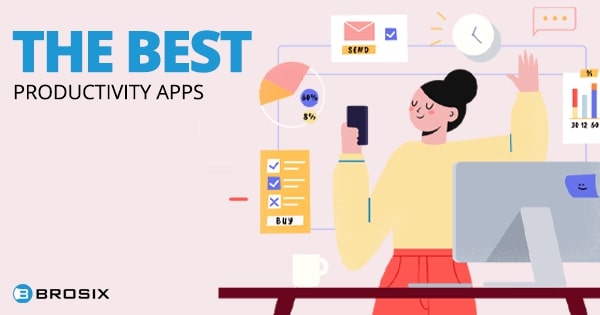A communication model is the framework we use to share messages and thoughts with others.
They dictate how we interact with the people around us and help to facilitate understanding and collaboration. However, very few people have a clear understanding of just how diverse communication models can be.
On the surface, communication seems like a relatively simple concept. We reach out to others using our voice, messaging apps, video tools, and in-person interaction. But our styles and modes of communication can vary drastically from one situation to the next.
Understanding the different types of communication models and how they contribute to our interactions and relationships can be extremely valuable, particularly for business owners. After all, the more you know about how people communicate, the better you can set the scene for excellent internal and external conversations in your workplace.
What Are the 8 Models of Communication?
Models of communication are essential frameworks that define how people interact to achieve specific goals. Communication is more complex than most people realize. It can involve various forms of information (from written text to diagrams) as well as multiple people with different communication styles. Over the years, linguists and scientists have defined 8 major models of communication commonly present in the modern world.
These models are divided into three categories:
- Linear models: One-way communication methods
- Interactive models: Two-way communication methods
- Transactional models: Two-way conversations wherein the message becomes more complex as the event (discussion) progresses.
In any organization, the success of the business depends on the strength of communication between the people in it and those they interact with (clients or customers). Understanding communication models means individuals can make better decisions about which strategies to use when sending messages to colleagues, friends, and customers.
Once you understand the communication models in your business, you can leverage tools like Brosix to unify and empower your team. The Brosix encrypted messaging app combines convenient group-focused chat capabilities with voice, video, and even productivity tools like whiteboarding.
With this easy-to-use tool, every member of your team can stay connected, no matter what style of communication they prefer.
Let’s take a look at each of the major models of communication, in their respective categories.
Linear Models of Communication
Linear communication models refer to communication that happens in a single direction.
For instance, the broadcasts you send to your entire team through your encrypted messaging apps are a form of linear communication. They may elicit a response, but two-way discussions aren’t always necessary. In a linear communication model, there are three core components: the sender, the channel, and the receiver.
The sender transmits communication via a channel, such as a messaging application. The channel dictates the medium of the message (voice, visual, text, etc.). The receiver is the person who gets the message and takes meaning from it.
Linear forms of communication are most commonly used for business announcements, such as broadcasts, press release statements, and marketing campaigns. The most common linear models are:
1. Aristotle’s model of communication
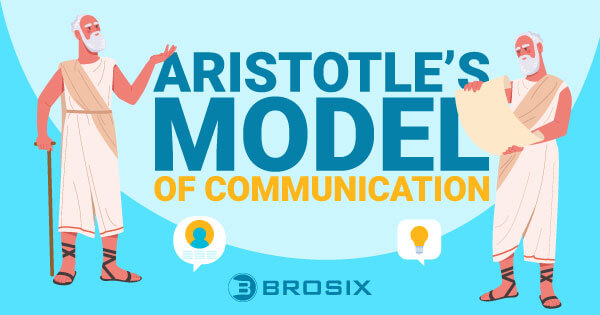
Aristotle’s model of communication is perhaps the oldest communication model most people are familiar with. Dating back to 300 BC, the model examines how people present messages in a persuasive, impactful manner. Aristotle said that to communicate effectively, we need to consider these 5 elements within any communication event:
- The Speaker: The person delivering the message
- The Speech: The information and how it’s portrayed
- The Occasion: The context surrounding the communication
- The Target audience: Who will be receiving the message
- The Effect: The goal of the communication
He also defined three core elements that improve communication. Ethos, or the credibility of the speaker and the authority they have in their space, is the first element. Pathos, which connects the speaker to the audience through different emotions, is the second. Finally, Logos, which signifies logic, is important to ensure the message is decoded correctly.
2. Lasswell’s model of communication
Lasswell’s model of communication, like Aristotle’s model, revolves around 5 key elements. However, these elements are presented as questions the speaker needs to ask. The core components of the Lasswell model include the following:
- Who: Who was responsible for sending the message?
- What: What information needs to be portrayed in the message?
- Which channel: Which method does the speaker use for communication?
- To Whom: Who is receiving the message?
- What Effect: What impact is the message intended to have?
The model suggests that every aspect of the communication process can impact the resulting “effect.” For instance, a broadcast about productivity sent through a productivity app by a business leader is likely to have more of an impact than the same message mentioned in passing by a colleague. Similar to Aristotle, Lasswell also believed that each speaker should always consider their audience before they begin communicating, tailoring the message to their needs.
3. The Shannon-Weaver model of communication
One of the most popular models of communication in the modern world, the Shannon-Weaver model, was one of the first to address the influence of “noise” in communication, which can disrupt a message. Shannon and Weaver developed their work during the Second World War, aiming to find out which channels were the best for effective communication.
The model, like many linear communication methods, looks at five key parts within an instance of communication: the sender, encoder, channel, decoder, and receiver. This model highlights the importance of encoding a message by turning it into written words, voice, video, or visuals. It also emphasizes the importance of a recipient being able to make sense of the message through decoding.
Shannon and Weaver suggest that common issues, such as noise or static on a radio broadcast, misspellings in an email, and other problems, can significantly influence the quality of communication. A newer version of the Shannon-Weaver model adds “feedback” as the sixth component of the framework, which makes the model more collaborative rather than simply linear.
4. Berlo’s S-M-C-R model of communication
Berlo’s model of communication is a little more detailed than some of the other linear frameworks we’ve looked at so far. This approach breaks communication down into four steps, with core components included in each of them:
- S: Source: The communication skills, attitudes, knowledge, societal system, and culture of the person sending the message.
- M: Message: The structure, elements, content, and management of the message, as well as any code, jargon, or specific language that may be used.
- C: Channel: How the message is transmitted and how it affects the senses of sight, hearing, touch, smell, and taste.
- R: Receiver: Who encounters the message, their attitude, knowledge, communication skills, societal system, and culture.
According to Berlo’s model, for successful communication, the source and the receiver need to have some commonalities. For instance, both the person sending the message and the person receiving it should have similar knowledge and speak the same language. The message needs to be constructed correctly to suit both the receiver and the channel on which it will be transmitted.
Interactive Models of Communication
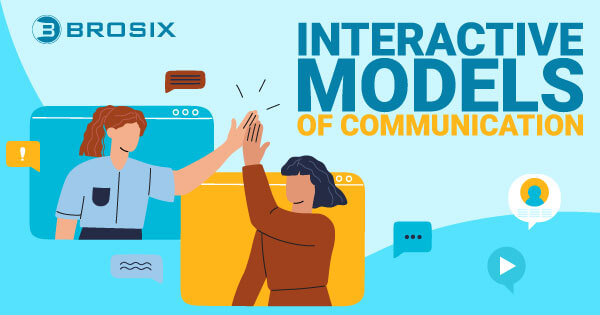
As you may imagine, communication models are far more collaborative than linear frameworks. Rather than focusing on one person sending a message, interactive models look at the connection between different people sharing a communication event.
Feedback and responses are considered, as well as what a leader or individual says during their initial message. Interactive communication models are used most commonly in a business environment for collaborative work, team discussions, and two-way conversations with clients. Let’s take a closer look at the core models of interactive communication.
5. The Osgood-Schramm model
Introduced by Osgood and Schramm, this is a circular model of communication where everyone involved in an interaction is treated equally. The sender and receiver in this model aren’t differentiated; instead, they’re simply defined as two parts of a valuable conversation.
The Osgood-Schramm model is usually used to describe synchronous interpersonal communication. The principles of the model include:
- Cycle of communication: Individuals in the communication process are constantly switching between the roles of “encoder” and “decoder”.
- Communication should be equal and reciprocal: Every party involved in the discussion is equally engaged and able to share their voice.
- Interpretation is crucial: Messages need to be presented in a way that is easy to interpret for both sides of the party to be understood.
The Osgood-Schramm model of communication also suggests that real-time interactions can reduce the amount of noise that can disrupt communications. Additionally, it believes ongoing clarification and active listening are crucial for positive conversations.
6. The Westley and Maclean model
Typically used when describing mass communication between groups, the Westley and Maclean model introduces various additional factors to discussions, such as environmental and cultural elements. According to this model, the process of communication begins with environmental factors rather than a sender or source producing information.
As one of the most complex models, this framework consists of nine components, including the environment, sensory experience, source or sender, object or orientation of the source, receiver, the orientation of the receiver, feedback, gatekeepers, and opinion leaders.
The Westley and Maclean model argues that how we communicate and the things we say are directly influenced by our perspective, background, and who we are. The model takes into account the culture, background, and beliefs of the person sending and receiving each message.
According to this model, “gatekeepers” and sensory experiences can also be important in depicting how a message is portrayed. The way we receive messages can influence how we feel about future interactions with a person. For instance, if someone sends a relatively streamlined message to us through a chat tool, we’re likely to consume the information quickly and respond appropriately.
Transactional Models of Communication
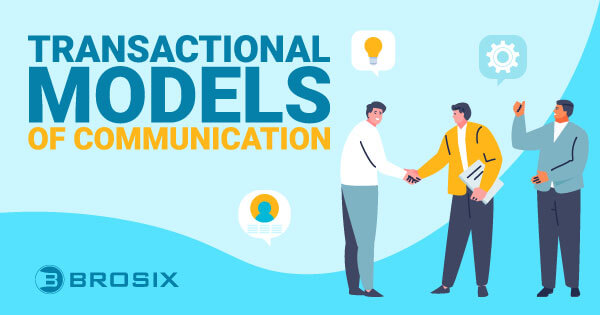
Transactional models are among the most dynamic modes of communication. They involve decoding and encoding elements, similar to interactive models, as well as consideration of communicators, messages, channels, and potential noise or disruptors.
What makes transactional communication models interesting is that they view each discussion or interaction as a “transaction.” In other words, communication is a cooperative process whereby two people are responsible for influencing the outcome of the conversation.
Transactional models also highlight that we don’t just share information through communication but also form bonds, unlock value, and create relationships. The core transactional models of communication include:
7. Barnlund’s transactional model
Barnlund’s model explores the immediate-feedback communication between people. The multi-layered approach suggests various aspects are crucial to determining how effective a conversation is. For instance, cues such as private cues (a person’s background), public cues (environmental context), and so on, can influence how we speak.
In the Barnlund transactional model, both the receiver and sender of the message are responsible for ensuring the conversation leads to the right outcome. Additionally, this model suggests noise, such as external disruptions and communication channel issues, can cause differences in how we perceive things.
Barnlund’s transactional model of communication can be extremely useful for companies using messaging tools, where cues like cultural or environmental factors can alter the meaning of a message. For instance, in a global workplace, someone asking for the “upcoming holiday” off could be asking for a variety of different dates, depending on where they’re located.
8. Dance’s Helical model
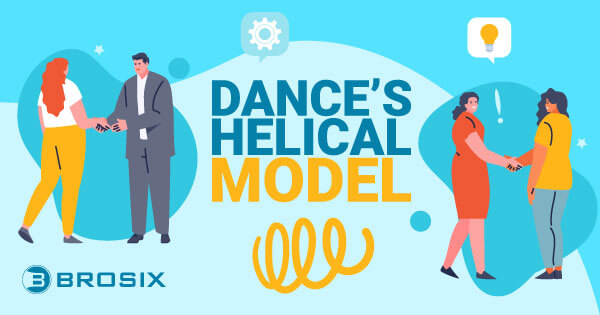
The Dance Helical model considers communication as a circular process, wherein conversations become more complex as we dive deeper into the interaction. It’s often represented visually by a helical spiral. The model indicates that we gradually improve how we communicate over time, underscoring the importance of feedback in communication.
As we communicate with each person in our team, for instance, we learn more about the situation in question and the person we’re connected with. This allows us to expand our circle and build on the information we’re sending to achieve specific goals.
Also, Dance’s Helical model views communication as constantly evolving. As we learn and develop alongside our team members, our understanding of them and the world in which we’re operating continues to evolve, allowing us to achieve our goals more effectively.
Learning From Communication Models
As the world around us evolves, the methods we use to communicate are constantly transforming. However, even as we branch into new landscapes like instant messaging and video conferencing, it’s important to pay attention to the basic communication models we use every day.
Communication models help us to understand the common steps involved in communication and how different aspects can influence the outcome of each message we send. While none of the models above fully represent communication as it stands today, being aware of them can help us avoid potential problems with conversations and improve our communication skills.
No matter which communication model your business relies on, Brosix can help you nurture a culture of collaboration and cooperation in your company. The all-in-one communication app makes it easy to connect employees from across different landscapes with encrypted messaging, video, voice, and instant business-wide notifications.
What’s more, Brosix comes packaged with a host of productivity tools to help you transform your employees’ conversations into action, such as screen-sharing tools and whiteboarding features.




